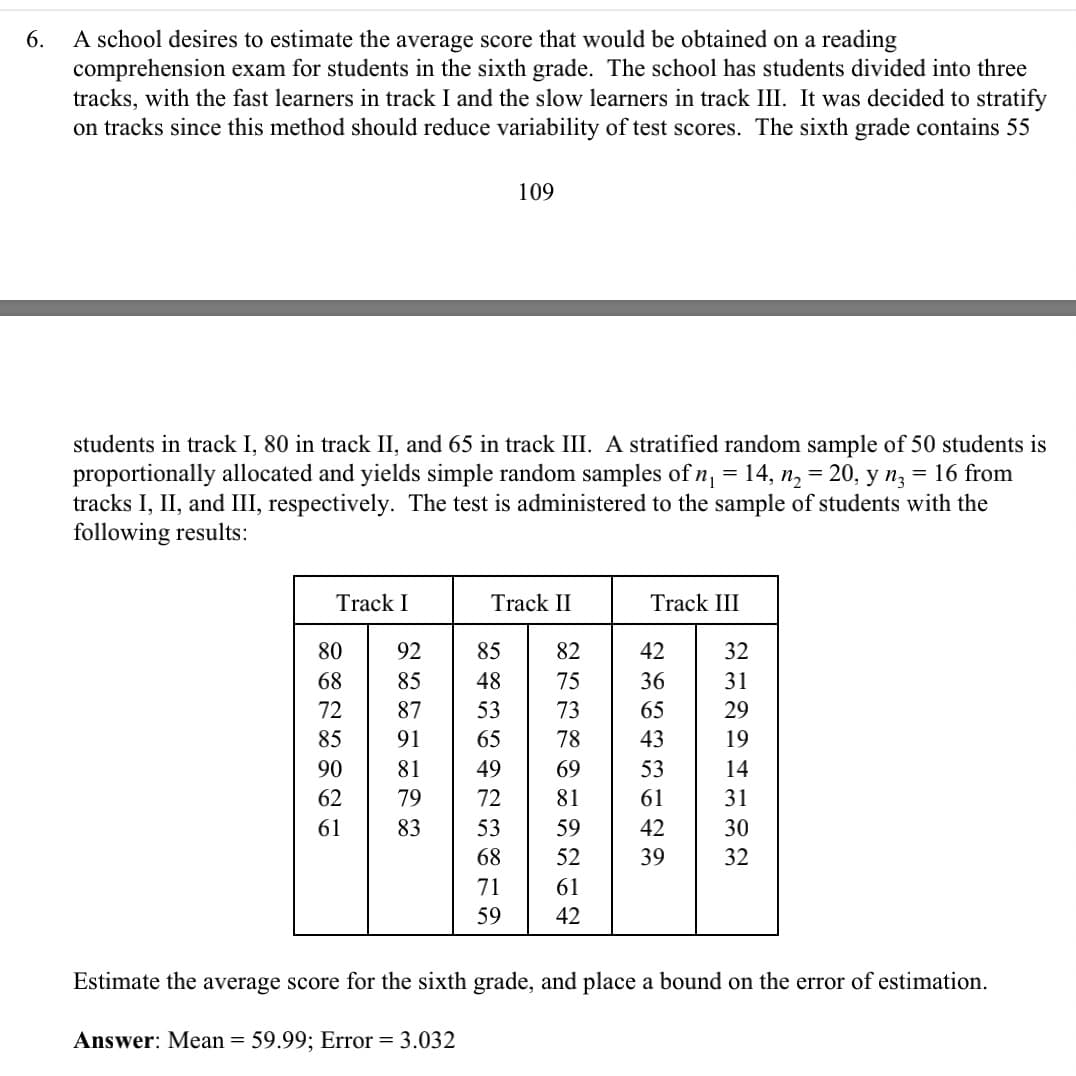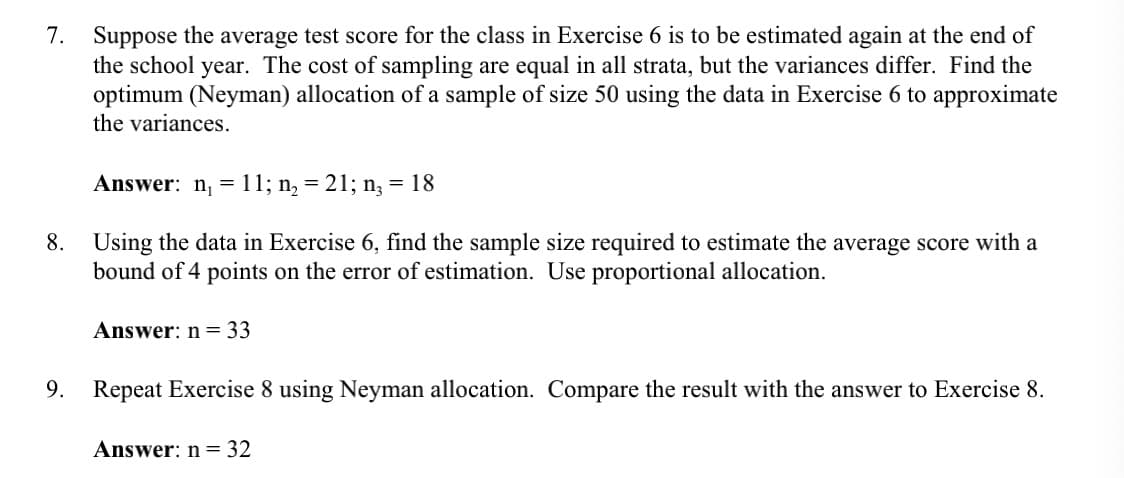6. A school desires to estimate the average score that would be obtained on a reading comprehension exam for students in the sixth grade. The school has students divided into three tracks, with the fast learners in track I and the slow learners in track III. It was decided to stratify on tracks since this method should reduce variability of test scores. The sixth grade contains 55 students in track I, 80 in track II, and 65 in track III. A stratified random sample of 50 students is proportionally allocated and yields simple random samples of n₁ = 14, n₂ = 20, y n3 = 16 from tracks I, II, and III, respectively. The test is administered to the sample of students with the following results: Track I 80 92 68 85 72 87 85 91 90 81 62 79 61 83 Track II 85 48 53 65 49 72 53 68 109 71 59 273K8NSENT 75 69 81 59 52 61 42 Track III 42 36 65 43 53 61 42 39 32 31 29 19 14 31 30 32 Estimate the average score for the sixth grade, and place a bound on the error of estimation. Answer: Mean = 59.99; Error = 3.032
6. A school desires to estimate the average score that would be obtained on a reading comprehension exam for students in the sixth grade. The school has students divided into three tracks, with the fast learners in track I and the slow learners in track III. It was decided to stratify on tracks since this method should reduce variability of test scores. The sixth grade contains 55 students in track I, 80 in track II, and 65 in track III. A stratified random sample of 50 students is proportionally allocated and yields simple random samples of n₁ = 14, n₂ = 20, y n3 = 16 from tracks I, II, and III, respectively. The test is administered to the sample of students with the following results: Track I 80 92 68 85 72 87 85 91 90 81 62 79 61 83 Track II 85 48 53 65 49 72 53 68 109 71 59 273K8NSENT 75 69 81 59 52 61 42 Track III 42 36 65 43 53 61 42 39 32 31 29 19 14 31 30 32 Estimate the average score for the sixth grade, and place a bound on the error of estimation. Answer: Mean = 59.99; Error = 3.032
Glencoe Algebra 1, Student Edition, 9780079039897, 0079039898, 2018
18th Edition
ISBN:9780079039897
Author:Carter
Publisher:Carter
Chapter10: Statistics
Section: Chapter Questions
Problem 13PT
Related questions
Question

Transcribed Image Text:6.
A school desires to estimate the average score that would be obtained on a reading
comprehension exam for students in the sixth grade. The school has students divided into three
tracks, with the fast learners in track I and the slow learners in track III. It was decided to stratify
on tracks since this method should reduce variability of test scores. The sixth grade contains 55
1
students in track I, 80 in track II, and 65 in track III. A stratified random sample of 50 students is
proportionally allocated and yields simple random samples of n₁ = 14, n₂ = 20, y n3 = 16 from
tracks I, II, and III, respectively. The test is administered to the sample of students with the
following results:
Track I
80
68
72
85
90
62
61
Track II
92
85
87 53
91
81
79
83
85
48
109
65
49
72
53
68
71
59
253K8TENG
75
73
78
69
81
59
61
42
Track III
65434985
42
61
42
32
31
29
19
14
31
30
32
Estimate the average score for the sixth grade, and place a bound on the error of estimation.
Answer: Mean = 59.99; Error = 3.032

Transcribed Image Text:7. Suppose the average test score for the class in Exercise 6 is to be estimated again at the end of
the school year. The cost of sampling are equal in all strata, but the variances differ. Find the
optimum (Neyman) allocation of a sample of size 50 using the data in Exercise 6 to approximate
the variances.
Answer: n₁ = 11; n₂ = 21; n₂ = 18
8. Using the data in Exercise 6, find the sample size required to estimate the average score with a
bound of 4 points on the error of estimation. Use proportional allocation.
Answer: n = 33
9. Repeat Exercise 8 using Neyman allocation. Compare the result with the answer to Exercise 8.
Answer: n = 32
Expert Solution
This question has been solved!
Explore an expertly crafted, step-by-step solution for a thorough understanding of key concepts.
Step by step
Solved in 5 steps with 3 images

Recommended textbooks for you

Glencoe Algebra 1, Student Edition, 9780079039897…
Algebra
ISBN:
9780079039897
Author:
Carter
Publisher:
McGraw Hill

Holt Mcdougal Larson Pre-algebra: Student Edition…
Algebra
ISBN:
9780547587776
Author:
HOLT MCDOUGAL
Publisher:
HOLT MCDOUGAL

Glencoe Algebra 1, Student Edition, 9780079039897…
Algebra
ISBN:
9780079039897
Author:
Carter
Publisher:
McGraw Hill

Holt Mcdougal Larson Pre-algebra: Student Edition…
Algebra
ISBN:
9780547587776
Author:
HOLT MCDOUGAL
Publisher:
HOLT MCDOUGAL